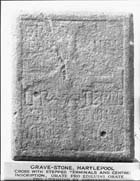Select a site alphabetically from the choices shown in the box below. Alternatively, browse sculptural examples using the Forward/Back buttons.
Chapters for this volume, along with copies of original in-text images, are available here.
Object type: Complete recumbent grave-marker [1]
Measurements: L. 21.6 cm (8.5 in); W. 17.5 cm (6.8 in); D. 3.8 cm (1.6 in)
Stone type: Oolitic limestone
Plate numbers in printed volume: Pl. 85.440-442
Corpus volume reference: Vol 1 p. 100
(There may be more views or larger images available for this item. Click on the thumbnail image to view.)
The sides are rough, but the back is dressed smooth.
A (broad): The face is surrounded by a flat slightly bevelled border and is quartered by a cross, type A4, in low relief. Its centre is very worn but could have been diamond-shaped. Latin inscriptions, probably in Anglo-Saxon capitals throughout, extend over all four quadrants:
(a) Upper two quadrants:
OR[A] II [—]
[E—] II [—-]
(b) Lower two quadrants:
OR[A] II TEPRO
[—] II [. .]D[. .]
[—E—] I I [—UI]D
The inscriptions are much weathered, so it is difficult to see even the letters. Okasha (1971, 78) reads in (ii): ORATE PRO [GE] R [-] ED [LES] U [ID], let alone the reading of Brown (1921, 65): (i) ORA PRO EDILVINI: (ii) ORATE PRO VERMUND ET TORHTSUID. This reconstruction repeats names found on other Hartlepool stones (see 3 and 4).
The inscriptions are very crowded, and the repetition of the request for prayer suggests that the one in the lower quadrants may be secondary. Since it is not possible to determine the form of the names, one can only speculate as to their gender.
This stone, though markedly worn, is distinctive in several ways. The form of the cross which is stepped at the ends of the arms and in the centre, is not found elsewhere among the Hartlepool stones, The bevelled moulding is comparable with 4, as is the request for prayer, but the second at least of the requests here is in the plural, which most readily makes sense if the stone were visible above the grave or inside a church. Since both this and 4 were found in a cemetery, and since both are weathered, they were probably on the surface of graves.



